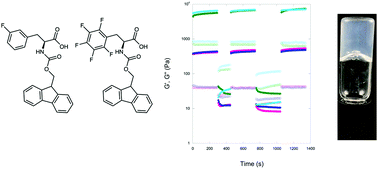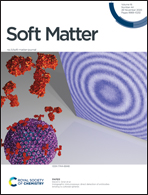Impact of gelation method on thixotropic properties of phenylalanine-derived supramolecular hydrogels†
Abstract
Supramolecular hydrogels formed by noncovalent self-assembly of low molecular weight (LMW) agents are promising next-generation biomaterials. Thixotropic shear response and mechanical stability are two emergent properties of hydrogels that are critical for biomedical applications including drug delivery and tissue engineering in which injection of the hydrogel will be necessary. Herein, we demonstrate that the emergent thixotropic properties of supramolecular phenylalanine-derived hydrogels are dependent on the conditions in which they are formulated. Specifically, hydrogels formed from fluorenylmethoxycarbonyl (Fmoc) modified phenylalanine derivatives, 3-fluorophenylalanine (Fmoc-3F-Phe) and pentafluorophenylalanine (Fmoc-F5-Phe), were characterized as a function of gelation conditions to examine how shear response and mechanical stability properties correlate to mode of gelation. Two distinct methods of gelation were compared. First, spontaneous self-assembly and gelation was triggered by a solvent exchange method in which a concentrated solution of the gelator in dimethylsulfoxide was diluted in water. Second, gelation was promoted by dissolution of the gelator in water at basic pH followed by gradual pH adjustment from basic to mildly acidic by the hydrolysis of glucono-delta-lactone. Hydrogels formed under solvent exchange conditions were mechanically unstable and poorly shear-responsive whereas hydrogels formed by gradual acidification were temporally stable and had highly shear-responsive viscoelastic character. These studies confirm that gelation environment and mechanism have a significant influence on the emergent properties of supramolecular hydrogels and offer insight into how gelation conditions can be used to tune hydrogel properties for specific applications.

- This article is part of the themed collection: Peptide Soft Materials


 Please wait while we load your content...
Please wait while we load your content...